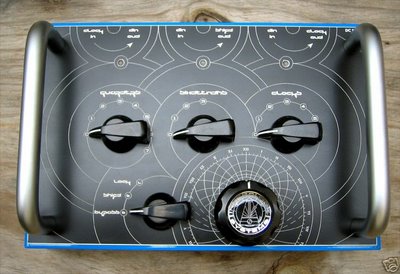Note: Auction links are affiliate links for which the site may be compensated.

via
this auction
"The 7-Bit Sound NAND Drone Synth is ballistic Lo-Fi synth box that packs a heavy punch, with 4 internal gated oscillators
NAND Drone synth is easy to use and is controlled in the following ways:
· The First knob controls oscillation frequency of the number 1 oscillator that is gated to the number 2 oscillator
· The Second knob controls oscillation frequency, by turning the First switch we open or close the gate.
· The Third knob controls oscillation frequency of number 3 oscillator that is gated to number 4 output oscillator which is also gated to the number 2 oscillator
· The second switch controls the gate between number 3 and number 4 oscillator.
The Vaco Loco Zira came out of an idea to see how small a fully equipped and versatile synth could be built.
The Zira features Two oscillators, each with 48 waveforms that were favourites from the Monowave. A sub oscillator, linked to oscillator one. The Sub oscillator has a level control, oscillators one and two can be switched on or off. Note offset for Patch +/- two octaves, second oscillator has note detune of +/- two octaves and fine tune. Hard Sync of oscillator two to oscillator one's pitch.
The Zira is based on the Korg NJM2069AD Filter/VCA chip. This 4-pole low pass filter is the same filter chip used in the Poly800, DW8000, DW6000 and DSS-1
Zira comes fully assembled in a clear acrylic housing, and is a very limited edition release, never to be seen again once stocks are sold out.
Features:
· Two oscillators, each with 48 waveforms
· One Sub oscillator
· Hard Sync of oscillators
· Two ADSRs, one VCF, one VCA
· One LFO
· Multiple routing options
· 64 patch memories
· MIDI updatable firmware
Specifications:
· 2 Oscs: Each with 48 waveforms, I picked 48 of my favourites from the Monowave. A sub oscillator, linked to oscillator one. The Sub oscillator has a level control, oscillators one and two can be switched on or off.
Note offset for Patch +/- two octaves, second oscillator has note detune of +/- two octaves and fine tune.
Hard Sync of oscillator two to oscillator one's pitch.
· VCF: The Korg NJM2069AD is used in the prototypes for the filter. This 4-pole low pass filter is the same filter chip used in the Poly800, DW8000, DW6000 and DSS-1
· VCA: Very high signal to noise ratio and incredibly clean sounding, again, the prototype uses the NJM2069AD.
· EG's: One for Filter and one for VCA, both are ADSR type. They have Linear attack and exponential decay and release curves.
These go from very quick (~3mS) to a many seconds for each stage (~48 Seconds).
· LFO: The LFO has 4 wave forms, Sinewave, sawtooth, square and random. the LFO is routable to oscillator pitch, filter cut off and filter resonance.
A delay parameter allows the LFO to come "fade in" with an adjustable delay.
It also has a key sync mode, when on the LFO is forced to reset when a new key is pressed and when the LFO cycle has finished it rests at that value.
· Display: The display uses four 7 segment displays, the same as GorF and Tron.
· MIDI: MIDI CC for each parameter, receipt of Patch change (64 patches).
· I/O: The Connections could not be simpler, power in (6 to 12V DC), MIDI in and Audio out.
Video Demos:"
YouTube Published on Apr 16, 2012 by VacolocoSynth
"A quick run through of Zira and it's features."
Zira Demonstration
Published on Apr 16, 2012 by VacolocoSynth
"A quick run through of Zira and it's features."
New Boot Loader
Uploaded by VacolocoSynth on Feb 23, 2012
"Quick demonstration of the new, faster and more reliable, boot loader.
This demo shows an update for Zira, but the same boot loader will be used for all new projects from this point forward."




























































